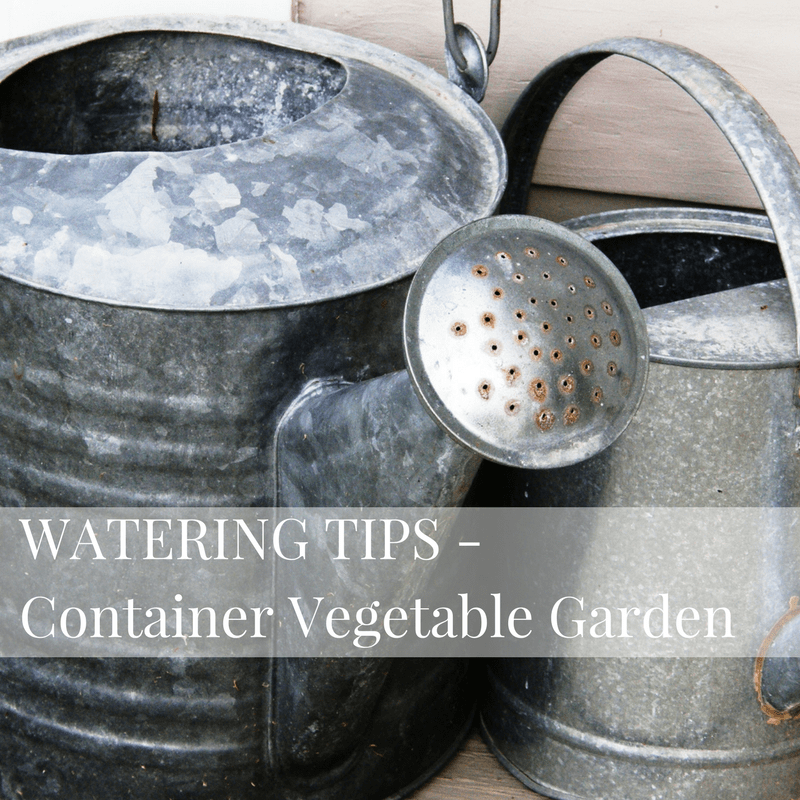These 9 easy watering tips for a container vegetable garden will help you keep your vegetable plants healthy and productive all season long.

9 Watering Tips for a Container Vegetable Garden
Why am I giving you 9 watering tips for a container vegetable garden? After all, isn’t watering the easy part?
Yes – and no.
Would you believe that most people water their plants incorrectly?
Proper watering techniques can help your plants produce more fruits and vegetables, stay healthier longer, and resist many microorganisms.
Plants need water to sustain the living tissues inside their cells. Water helps maintain cell wall rigidity, which keeps the leaves and stems firm.
Water also transport oxygen, macro, and micro nutrients from the soil up through the xylem tubes (like our veins) which reach the leaves. There, photosynthesis takes place, which produces the carbohydrates plants use for food.
You can see from this very basic description why water is essential for plants. How much water a plant needs depends on the plant itself.
Some plants, such as cactus and succulents, evolved in harsh, arid conditions. They developed unique adaptations to help them conserve water. Too much water for a cactus can kill it.
Tropical plants, on the other hand, evolved in an environment with abundant rainfall. Such plants suffer when they do not receive plentiful rain.
Garden vegetables vary in their needs for water. Vegetables in pots and containers, however, need daily watering.
Why? Because there isn’t much soil space inside your container. The soil dries out through evaporation into the air and through the plant’s own water use. In hot weather, you may need to water plants twice daily.
Here are 9 watering tips that have made my life with container vegetable gardening so much easier. Use these to keep your container vegetables happy and thriving.
9 Watering Tips for Container Vegetable Gardens
- Make it easy to water your containers: The easier it is to water your container vegetables, the more you’re likely to water them. Locate the pots or containers near your garden hose. Fill water buckets and watering cans immediately after you use them so they are waiting for the next round of water. If you need more watering cans, clean plastic milk jugs or juice containers work just fine.
- Water until the liquid runs out the bottom of the pots: Watering container vegetable gardens is a little different than watering indoor house plants. Outdoor containers should be watered until you actually see water running out from the holes in the bottom of the pots or containers. If you’re worried that water is going to spill off of your apartment balcony and onto the neighbor’s laundry hanging on the line below, set the containers on old pallets and stick pans, old baking sheets, or trays under the containers to catch the water.
- Set pots and containers on a gravel tray: A tray filled with coarse gravel or stones catches drips and water. It keeps pots elevated so the water doesn’t pool underneath and ruin your deck or the neighbor’s patio. (See my note above). As the water evaporates in the hot summer sun, it will cool down the container slightly, keeping the soil moist for longer periods of time.
- Use mulch: You can put mulch or clean garden straw (available from the garden center) around the top of the soil in larger containers to conserve water.
- Use a hose with a variable spray: Variable spray nozzles change the force of the water coming out of the hose. A gentle, steady stream of water onto the soil is better than a blast of a jet spray, which can push soil down and compact it or wash it out of the pot.
- Water in the morning: Watering in the morning gives your plant enough moisture for the day. It also gives the sun a chance to dry off the leaves. This can prevent conditions favorable to the development of many blights, mildews, and other diseases.
- Water the roots, not the leaves! This is perhaps the number one mistake I see among backyard gardeners. They spray the hose on the leaves of the plant and the soil remains dry. Always aim water at the soil, where the roots of the plants are buried. That’s where water does the most good and how your plant absorbs water.
- Water regularly: Get into a watering schedule that you can maintain. Regular, even watering prevents blossom end rot in tomatoes, helps avoid cracking in tomatoes, radishes, and other vegetables, and supports the plants’ growth and development. Uneven watering stresses your plants and can cause problems in the developing vegetables and fruits.
- Plastic pots conserve water: Plastic slows down water loss. Clay pots ‘breathe’ and the pores in the clay speed evaporation. White plastic heats less than black plastic pots or containers.
One Thing NOT to do to Conserve Water
One thing people try to do to conserve water – which does NOT work – is to plant vegetables in pots or containers without drainage holes. The mistaken thinking is that this will keep more water in the container and they will have to water less frequently.
Problems arise when torrential rains arrive. Perhaps a thunderstorm dumps an inch of rain or more. A week of rain showers leaves your containers soaking wet. The water has no place to drain, the roots rot, and the plant dies.
Although container vegetable gardens do need a lot more watering than in-ground gardens, the rewards of growing your own produce are well worth it.
That wraps up my 9 tips, tricks, and hacks for watering a container vegetable garden. Take care, happy gardening, and keep growing!